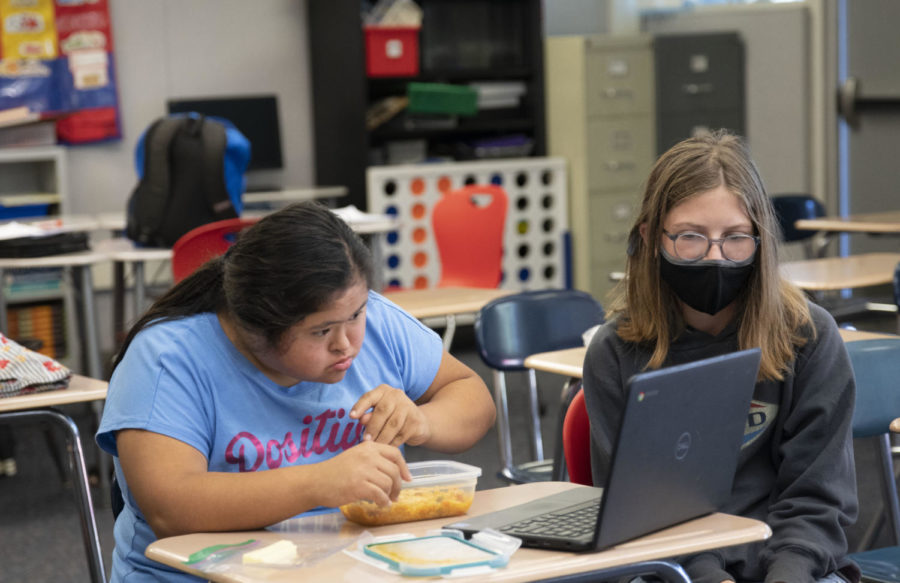Our road to inclusion
RUHS’ path to an accessible campus and accepting atmosphere
The friendship circle, led by junior Zachary Steinbrun, seeks to create meaningful friendships between teen volunteers and children with special needs. At the first meeting, students bonded with others through pizza, games, and TV shows. The club meets Mondays in Room 503. Photo by Keara Antonelli.
From taking the stairs, to walking through crowds and picking future classes, there are countless things that the majority of students can do with ease. But for roughly 1,225 “disabled” students in RBUSD, getting around campus can be a daily struggle.
Stephanie Powell, one of the essential skills teachers at RUHS, teaches students independent life skills such as how to manage money, take care of a household and make their meals. Powell specifically works with students with moderate to severe disabilities, which includes a range of students from those with intellectual disabilities to those with medically fragile disabilities, and she often sees her students struggling to navigate the school.
“Getting around school can be challenging for students without disabilities too, but for Dr. Mallet and my students, they need to be put in a position where it’s routine and they have to see it on a daily basis,” Powell said. “A lot of our students can’t get around campus without support [from staff and aids], so it’s very challenging for our students to be able to just navigate on their own.”
But, Powell feels that there are ways that RUHS can help her students around campus even more.
“We need some more support here, as far as staffing. Also color coding or even using shapes; if the students follow all the squares to this side of the campus or follow all the triangles to that side of the campus, something like that might be able to support our students. And definitely educating the entire school on our students, because you have the general ed population and then you have the special education population, and so most of the time our general education population doesn’t really know how to deal with or even understand students with special needs,” Powell said.
In addition to making some of these changes, Powell hopes to see her students included in more school activities.
“I’d like to see more of our students included with doing certain things that general ed kids do on campus, whether that’s cleaning up the campus or being part of a club. But also have the support to support them in that club. It’s one thing to just push them into a club and say ‘Okay, here he is, work with him,’ but to have the support behind that as well,” Powell said.
Still, the school has made improvements over the past few decades. It has “expanded programs to allow [students with disabilities] more access so that they can not only partake in classes, but also find levels of success in those classes,” according to the Teacher on Special Assignment Jeffery Rosadini. This means he is responsible for helping with interventions for students who are struggling.
Some physical features on the school’s campus that help mitigate its inconvenience include ramps, wheelchair elevators and handicap parking spaces, which were incorporated on campus over the past 17 years, according to Director of Facilities Management and Construction Fred Naile. When the school does any kind of construction on campus, it must be approved by the Department of State Architects, who ensure that the requirements of the American Disability Act (ADA) are met. The ADA was signed into law in July of 1990 and guarantees that people with disabilities have the same opportunities as everyone else to participate in mainstream life. This can include requirements for access to properties, buildings, restrooms and parking.
But aside from building new ramps and lifts, the school has other ways of helping disabled students at school.
“At freshman orientation, we have a flock of counselors and support staff to help students have a better orientation of the campus. There are transition meetings for students with special needs that come over here, so that they can get some face-time to kind of help navigate things like picking your classes, because it’s hard coming over to high school from middle school,” Rosadini said. “But overall, students with needs are in all classes. They’re mainstreamed as much as possible in all the regular classes because we always want to put them in the least restrictive environment and have them with all their peers. We also [had] Inclusion Day [last Friday], and that’s a big thing that we’re celebrating. I mean, Inclusion Day is taking on the forms of many ways being inclusive, and amongst that is students with needs.”
Inclusion Day is a part of Inclusion Week, a district-wide celebration of Disability Awareness. On Inclusion Day, the school will encourage students and staff to wear purple for a “purple out” and ask students to write personal pledges on post-it notes about how they plan to be more inclusive in the community. The goal, according to Assistant Principal Jennifer Chatmon, is to see “3,000 sticky notes flapping in the wind.”
This year is the first that RBUSD has celebrated Inclusion Week, but it plans on making it a yearly event.
By incorporating events like Inclusion Day and making modifications on campus, RUHS is striving to create a more disability-friendly environment.
“When you work with students with needs and you see them reach a goal, and you understand how much drive and perseverance it has taken them to reach that goal, it’s very satisfying. For some students, school just comes easy to them and they just fly through and don’t have to study,” Rosadini said. “But for other students, school has never come easy. So to just see that glimmer in their face when they reach that level of success is really, really special.”
Happy, free, confused and lonely in the best way.



